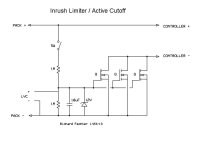So it sounds like the inrush to the caps is high enough to blow the one with the path of least resistance.
If the pack is suddenly connected to the caps in the controller (even with no motor) the inrush current will be very high, possibly like 1000 amps depending on the voltage and wiring resistance and cap ESR,
I think slowing down the turn on time will let the FETs act like precharge resistors enough to dramatically reduce the current spike. Try a bigger capacitor like at least 10uF. If it gets too big, it might not be fully on by the time you want to draw some real power. I think even at 100uF it would be up in a couple of seconds. You can measure the gate voltage as you switch on the gate drive and see how long it takes to get up to 2-3 volts. I think a 4310 will be amost fully on by 5v and about as on as it gets by 9V (data sheet would tell). You can do this with no load.
I think the left hand one prefers to blow first because it has the lowest wiring resistance. Feeding the negative wires from opposite sides would even this out, but that would only randomize which one blows first if they get too much current.
If the pack is suddenly connected to the caps in the controller (even with no motor) the inrush current will be very high, possibly like 1000 amps depending on the voltage and wiring resistance and cap ESR,
I think slowing down the turn on time will let the FETs act like precharge resistors enough to dramatically reduce the current spike. Try a bigger capacitor like at least 10uF. If it gets too big, it might not be fully on by the time you want to draw some real power. I think even at 100uF it would be up in a couple of seconds. You can measure the gate voltage as you switch on the gate drive and see how long it takes to get up to 2-3 volts. I think a 4310 will be amost fully on by 5v and about as on as it gets by 9V (data sheet would tell). You can do this with no load.
I think the left hand one prefers to blow first because it has the lowest wiring resistance. Feeding the negative wires from opposite sides would even this out, but that would only randomize which one blows first if they get too much current.


